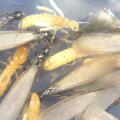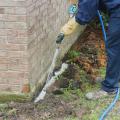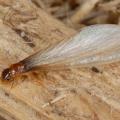Methods of Termite Control
Before considering different methods of termite control, it is important to recognize that there are two major categories of termite treatments based on when the treatment is applied: preconstruction treatments and postconstruction treatments.
Preconstruction treatments are protective treatments that are applied or installed as a building is being built, and shortly after the building is completed. Obviously, preconstruction treatments can only be applied at one point in the life of a building. Some types of treatments and physical barriers can only be applied at this time, but there are other methods of termite treatment that can be applied either as preconstruction treatments or postconstruction treatments. Most preconstruction termite treatments installed in Mississippi utilize liquid termiticides. It is important that any subsequent additions to a building also be properly pretreated.
Installation of a liquid termiticide pretreatment is a two-step process that involves establishing a horizontal barrier of treated soil underneath the building and a vertical barrier of treated soil around the exterior building foundation.
- Step 1. The horizontal barrier must be installed before the slab or foundation for the building is poured, but after all form boards and other preparation for pouring the slab or foundation is completed.
- Step 2. The vertical barrier, or exterior perimeter treatment is applied shortly after the building is completed and the final exterior perimeter grade is established.
MSU-ES Publication 2765, What Home Builders Need to Know about Termites, specifically addresses preconstruction termite treatments.
Postconstruction treatments are treatments that are applied to older, established buildings. Because termiticide treatments do not last indefinitely, buildings need to be periodically re-treated for termites in order to maintain termite protection, and a building that is many decades old may have received several termite treatments. Postconstruction treatments may be applied preventively or remedially. Even in the absence of active termite infestations, preventive treatments may be required simply because of the amount of time that has passed since the last termite treatment or in response to some type of problem that has compromised the treatment.
Remedial treatments are applied in response to detection of an active termite infestation. Depending on the situation, remedial treatments may be either partial treatments that are applied only to the area of the building where the infestation has been detected or, more commonly, a remedial treatment may involve treatment of the entire building. Partial treatments are only appropriate for situations in which there is good reason to believe the majority of the building is still properly protected and the active infestation is believed to be limited to a particular area of the building.
MSU-ES Publication 2568, Protect Your House from Termites, specifically addresses postconstruction termite treatments.
Methods of termite control. Common methods of termite control include insecticide treatments, as well as various types of physical barriers and construction practices. However, insecticides are the primary method of controlling termites in Mississippi and throughout the Southeast. Physical barriers are used mainly as supplemental protection in new construction.
Liquid termiticide treatments. (Figure 1) Liquid termiticide is the most commonly used method of controlling termites. Liquid termiticides are insecticides that have been specifically developed for termite control. These products are diluted in water and applied to the soil immediately under or around the foundation of a building to establish a zone of treated soil that will control termites that attempt to tunnel through it. This takes advantage of the foraging behavior of subterranean termites, as well as their normal need to constantly return to the soil for moisture. In addition to safety and efficacy against termites, one of the most important criteria for a good termiticide is the length of residual control the product will provide. Some of the better soil-applied termiticides will provide control for 8 to 12 years or longer. Active ingredients of products recommended for use as liquid termiticides include: fipronil, imidacloprid, chlorantraniliprole, permethrin, cypermethrin, and bifenthrin. Liquid termiticides are widely used both for preconstruction and postconstruction termite control.

Foam termiticide treatments. (Figure 2) Foam termiticide treatments are insecticides that are diluted in water with a special foaming agent to form an end-use product with a consistency similar to that of shaving cream. Foam treatments are primarily used to supplement control provided by other types of termite treatments. They can be injected into wall voids and other voids in buildings and foundations where their consistency allows them to spread laterally and even upward to reach areas that could not be easily treated with a liquid termiticide. The foam breaks down quickly, leaving the insecticide residue on the inner surfaces of the treated void. Many of the insecticides used as liquid termiticides may also be mixed and used as foam termiticide treatments. Foam termiticides can be mixed and applied using special foam applicator tanks and are also available in premixed aerosol cans. Foam termiticide treatments are especially useful for control of aerial colonies of Formosan termites. Active ingredients most often used as foam termiticide treatments include fipronil and imidacloprid.
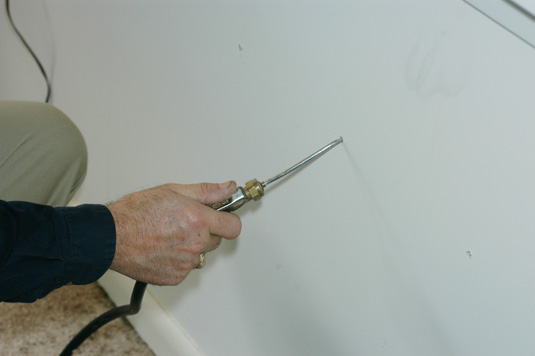
Borate treatments. Borate treatments are products that are diluted with water and applied as a preconstruction treatment to the lower two feet of studs, sill plates, exposed inside surfaces of exterior sheathing, and other framing elements in contact with the concrete slab. The treatment must be applied only after the building is in the “dried in” or “blacked in” stage of construction and before insulation and interior wall coverings are installed (see label for additional detail and complete instructions for treating basements and crawlspaces). Currently, disodium octaborate tetrahydrate is the only active ingredient that is approved for use as a termite preconstruction borate treatment. However, borate treatments may not be used as a stand-alone treatment in Mississippi. Buildings treated with a preconstruction borate treatment must also receive a final exterior perimeter treatment with an approved liquid termiticide. Essentially, the borate treatment replaces the sub-slab/sub-foundation horizontal barrier portion of a preconstruction treatment.
Wood preservatives/ “treated wood.” Note that this method of treatment is more appropriate for use in outdoor, extra-building construction rather than in homes and other buildings. Wood elements such as posts and landscape timbers that will be in direct contact with the ground must be chemically treated to protect against termites and wood decay fungi. Treated wood is used in fences, decks, exterior steps, and other outdoor/extra-building construction, but most building codes prohibit direct wood to soil contact within buildings. One reason for this is that, even with pressure-treated wood, treatments may not always reach to the center of the treated timber, and an in-ground post with an unprotected center provides ready access for termites.
Use of treated wood in sills, floor joists, and other sub-floor construction elements that are not in direct contact with soil will provide additional termite protection, but this should not be viewed as a stand-alone method of termite protection. Examples of active ingredients used in “treated wood” include: alkaline copper quaternary compound (ACQ), copper azole (CA), micronized copper quaternary (MCQ), copper dimethyl-dithiocarbamate (CDDC), and creosote. Chromated copper arsenate (CCA) was removed from market in 2003. Because of their water solubility and tendency to leach, borate treatments are not used to protect wood that will be in contact with the ground or exposed to weather.
Termite baiting stations. (Figure 3) Termite baiting stations use low doses of specially selected, slow-acting, non-repellent insecticides that are impregnated into wood or some other attractive substrate to control termites. There are two different types of baiting stations, in-ground stations and aboveground stations, but in-ground baiting stations are most common.

In-ground baiting stations are installed in the ground at periodic spacing around the outside perimeter of the building. Foraging termite workers discover the baiting stations, feed on the treated bait, and share this poisoned food with their colony mates, including the immature and reproductive stages. Bait treatments are slow-acting but ultimately result in the destruction of the colony. When properly installed and maintained, in-ground baiting stations are an effective long-term method of protecting buildings from termites.
Because they are slow-acting, baiting stations are usually not used as stand-alone treatments to control existing termite infestations. In this case, baiting stations may be placed around the building as usual, but known points of termite activity are also treated with a liquid termiticide. The goal here is to quickly control the existing infestation with the liquid treatment and then rely on the baiting stations for long-term preventive control.
Several different brands of termite baiting stations are available. In most cases the stations are originally baited with a piece of wood or other substrate that is attractive to termites but contains no insecticide. These stations are checked periodically, and when termite feeding is detected in a station, the old bait is replaced with a new bait that contains insecticide and the termites are allowed to continue feeding. However, some brands of baiting stations include the active ingredient in the original bait. Active ingredients used in currently available baiting stations include: noviflumuron, hexaflumuron, novaluron, diflubenzuron, hydramethylnon, and sulfluramid.
Some companies also produce aboveground baiting stations that are sometimes used to control termites in special situations, such as aerial colonies of Formosan termites.
Dry Termiticides. Dry termiticides are specialty products that are occasionally used to control, or for supplement control of, drywood or subterranean termites. Dry termiticides consist of a dry granular bait substrate impregnated with a small amount of termiticide. Dry termiticides are injected directly into active termite galleries with the goal of having the termites feed on the bait and distribute the toxicant throughout the colony. Such treatments are most useful for eliminating small, isolated infestations of drywood termites, or possibly as supplemental treatments for Formosan termites. Dry termiticide treatments are not recommended as stand-alone treatments for typical structural infestations of subterranean termites (eastern subterranean termites or Formosan termites).
Fumigation. Fumigation involves enclosing a termite-infested object inside a gas-proof enclosure and exposing it for a prescribed period of time to sulfuryl fluoride gas (Vikane or Termafume). Small objects, such as furniture, can be fumigated by placing them in special fumigation chambers. It is also possible to fumigate entire buildings by fully enclosing or “tenting” them in gas-proof coverings and releasing the fumigant inside the building. This is a costly and highly specialized method of termite treatment and only a few Mississippi companies are able to perform tent fumigations. However, tenting and fumigation is sometimes the only effective method of eliminating infestations of drywood termites that have spread to multiple locations within a building. Tent fumigation is also used to treat boats infested with Formosan termites, and is sometimes used to treat Formosan termites in buildings.
Physical termite barriers. Several types of physical termite barriers can be installed during initial construction of a building to make it more difficult for termites to enter the building and to make detection of subsequent termite infestations more likely.
Termite shields. Termite shields are thin pieces of metal flashing that are installed between masonry foundation support walls and support piers and the wooden sill plates or other wooden structural elements that are installed directly over the foundation. The objective is to prevent termites from being able to attack the building through unseen cracks in the masonry foundation wall and/or support piers. Termite shields are installed during initial construction. Properly installed shields should extend at least two inches beyond the foundation wall, be bent downward at a 45-degree angle, and have all gaps sealed. Termite shields are primarily used in houses with “conventional foundations” or crawl spaces so that they are installed at least 18 inches above the ground. Termite shields do not prevent termite attack and are not an effective stand-alone treatment for termites. However, properly installed termite shields make it much easier to detect termite infestations by forcing any invading termites to build mud shelter tubes around the termite shield where they are easier to see during routine inspections, resulting in more timely and effective treatment.
Termite collars. In buildings with slab-type foundations, plumbing and electrical conduit penetrations are common points of entry for termites. This is because concrete can pull away from pipes as it cures, resulting in cracks that are large enough to allow termites to enter the building unseen. Several companies sell stainless steel mesh or plastic collars that can be placed around pipes before pouring the slab to give a termite proof seal at such slab penetrations. While this does not prevent termite attack at other points in the building, it reduces the potential for termites to enter around plumbing penetrations, where inspection and early detection is difficult or impossible in a finished building.
Full foundation physical barriers. Several companies market physical termite barriers made of stainless steel mesh or other materials that are installed underneath the entire slab, or foundation, of a building, usually in combination with termite collars or termite shields. The objective is to create a termite-proof barrier underneath the building that will prevent termites from entering through unseen cracks and crevices in the slab or other foundation elements. However, such barriers do not provide complete protection and additional treatments using liquid termiticides or baits are still required to prevent termites from invading along the outside perimeter of the building.
Other building construction practices. Because building practices have such great effect on a building’s susceptibility to termite infestation, state and local building codes include requirements that address termite risks. The information presented here is not intended to replace building code requirements but only to point out some areas of greatest risk that should be given particular attention with respect to reducing potential for future termite problems.
- Remove all wooden stakes and form boards after construction is complete. Any untreated wood left in the ground or in contact with the soil constitutes a high risk for termite attack.
- Remove any tree stumps and roots during initial site preparation and do not leave or bury wood scraps, paper, or cardboard trash under or near crawl spaces or slabs. Termites will readily use such wood or cellulose resources to establish colonies that can eventually invade the building.
- Beginning with initial site preparation and grading and continuing through final grading and landscape installation, make sure proper drainage is achieved and maintained so that water does not accumulate in crawl spaces or against the exterior foundation wall. Such conditions are favorable to termites and also hasten degradation of termiticide treatments.
- On buildings with slab construction, be sure the lower edge of any type of siding, whether wood, vinyl, plastic, metal, or other material, is at least 6 inches above the final soil grade. Over time, accumulations of leaves, pine straw, mulch, or soil will reduce this gap and termites can readily enter buildings by tubing up the slab and behind siding. Having a minimum of 6 inches of clearance makes inspection and detection of termite infestations much easier and more successful.
- Drivit and stucco are two methods of exterior wall construction that have historically proven to be especially prone to termite problems when not properly installed. See comments above. Maintain a minimum of 6 inches of clearance between soil grade and lower edge of siding.
- Insulated concrete form (ICF) construction that extends below soil grade or within 6 inches of soil grade increases potential for termite infestation. Termites can tunnel through cracks between the form and concrete, or within the foam material the form is made of to access aboveground wood. Be sure to follow recommended construction practices and building codes when using ICF construction in areas designated as high risk for termite attack. Note that all of Mississippi is designated as “very high” regarding the potential for unprotected buildings to be infested by termites.
- Spray-on foam insulation is commonly used to insulate walls and roofs. However, when applied to foundation walls in crawl spaces, spray-on foam can increase risk of termite infestation, especially when less than 6 inches above soil grade.Termites will also tunnel through, or behind, spray-on foam insulation in walls and attics, making detection and control more difficult. This is especially common with Formosan termites (Figure 4).
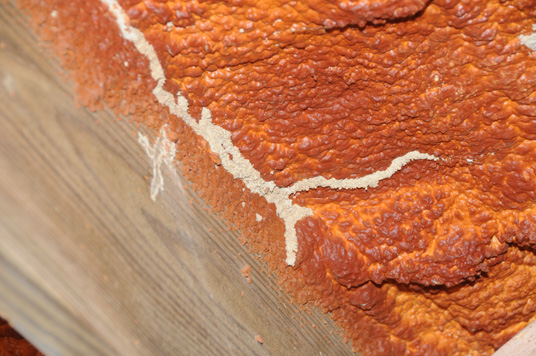
Figure 4. Termites do not eat sprayed-on foam insulation, but they will readily tunnel through it. - On buildings with conventional foundations, untreated wood should not be within 18 inches of soil grade and treated wood should be at least 6 inches above grade.
- Crawl spaces should be at least 18 inches high to allow proper access for termite inspections and treatments as well as for other maintenance and repair (see your local building code).
- Be sure exterior window ledges are properly installed and sealed to exclude rainwater. Window ledges should be sloped slightly away from the bottom of the window, rather than being level or sloping toward the bottom of the window. Other points where water may enter the building, such as roof and chimney flashing and plumbing and electrical penetrations in the roof, should also be well sealed. Moisture due to structural leaks is a key “conducive condition” that greatly increases risk of termite attack (Figure 5).
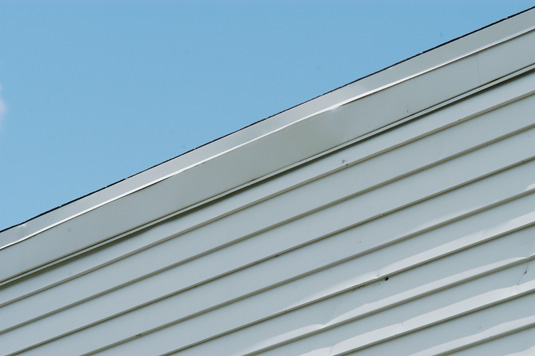
Figure 5. Storm damaged flashing on this apartment building allowed water to leak into second story walls, resulting in a heavy Formosan termite infestation. - Be sure termite pretreatments are applied properly and at the appropriate stage of construction. If a liquid termiticide pretreatment is used, be sure the horizontal barrier portion of the pretreatment is applied after all forming and other preparation for pouring the slab is completed but before the vapor barrier is put in place. Any soil disturbance that occurs after the liquid termiticide has been applied and before the slab is poured will create gaps in the horizontal barrier where termites can potentially enter the building.
- For buildings on which a liquid termiticide pretreatment is used, be sure the second part of the pretreatment, the exterior perimeter treatment or vertical barrier portion, is applied within a year of the date the construction is finished. Failure to apply this second half of the liquid termiticide pretreatment will result in a building that is highly susceptible to termite infestation. Beginning in 2008 pest control companies are required to place a sticker on the building’s electricity meter that shows when this final, exterior perimeter portion of the termite pretreatment was applied.
Dr. Blake Layton, Extension Entomology Specialist
Department of Entomology, Mississippi State University
Phone: 662-325-2960
Email: blake.layton@msstate.edu
Publications
News
Mississippi’s native subterranean termites have started swarming, and these structure-destroying insects will continue to swarm across the state over the next few months.
John Riggins, professor of forest entomology in the Mississippi State University Department of Agricultural Science and Plant Protection, said termites swarm to produce new colonies when the weather warms up, often after a rain.
Termites exist all over Mississippi and will eventually infest and damage any structure that contains wood or other cellulose components unless you properly protect those structures.
Invasive Formosan subterranean termites were first found in the state 40 years ago, and soon, these dangerous pests will swarm and threaten unprotected structures in about one-third of Mississippi’s counties.
Santos Portugal, Mississippi State University Extension Service urban entomologist, said Formosan termites typically swarm in the millions from early May to early June. They have the ability to infest and significantly damage structures much more quickly than native subterranean termites.
Success Stories
A dream of the Mississippi Pest Control Association and the Mississippi State University Extension Service is coming true after more than 20 years, thanks to a generous donation by one of Mississippi’s oldest pest-control companies.


